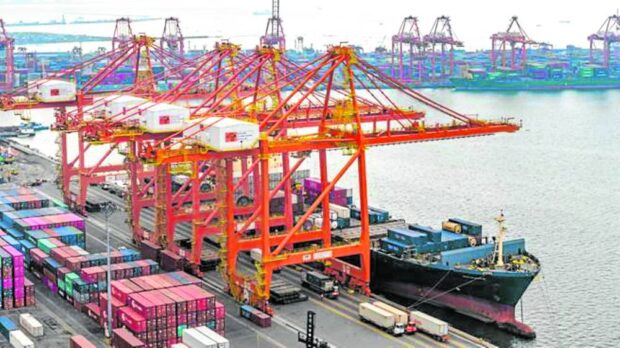
BETTER LOGISTICS A container ship’s cargo is unloaded by massive gantry cranes at the Manila International Container Terminal operated by ICTSI. —CONTRIBUTED PHOTO
The Philippines ranks 43rd out of 139 economies around the globe in the World Bank’s 2023 Logistics Performance Index (LPI) as digitalization has been allowing over the past five years developing markets to shorten port times much more than developed markets.
Released over the weekend, the report shows that the country is tied with seven other economies, including Czechia (or Czech Republic), Malta, Oman, Slovakia, Slovenia and Vietnam.
The latest ranking means an improvement of 17 notches from 60th place in the previous index results of which were released in 2018.
There were five other earlier studies, in which the Philippines placed 71st in 2016, 57th in 2014, 52nd in 2012, 44th in 2010 65th in the very first LPI in 2007.
The LPI measures the ease of establishing reliable supply chain connections and the structural factors that make it possible, such as the quality of logistics services, trade- and transport-related infrastructure, and border controls.
Economies are ranked based on indicators related to customs, infrastructure, international shipments, logistics competence and equality, timeliness, and tracking and tracing.
The World Bank noted that the seventh edition of the LPI comes after three years of unprecedented supply chain disruptions during the COVID-19 pandemic, when delivery times soared.
“Logistics are the lifeblood of international trade, and trade in turn is a powerful force for economic growth and poverty reduction,” said Mona Haddad, the World Bank’s global director for trade, investment and competitiveness.
“The Logistics Performance Index helps developing countries identify where improvements can be made to boost competitiveness.”
The report shows that across all potential trade routes, an average of 44 days elapse from the time a container enters the port of the exporting country until it leaves the destination port, add or take away 10.5 days.
The latest LPI shows that end-to-end supply chain digitalization, especially in emerging economies, is allowing countries to shorten port delays by up to 70 percent compared to those in developed countries.
“While most time is spent in shipping, the biggest delays occur at seaports, airports and multimodal facilities,” World Bank senior economist Christina Wiederer said.
Wiederer added that policies targeting these facilities can help improve reliability, including policies that are intended to improve clearance processes and investing in infrastructure, adopting digital technologies, and incentivizing environmentally sustainable logistics by shifting to less carbon-intensive freight modes and more energy-efficient warehousing.
The top three economies in the 2023 LPI are Singapore, Finland and Denmark. Sharing the bottom rungs at 138th are Afghanistan and Libya. INQ